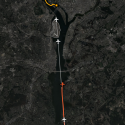- Joined
- Oct 21, 2009
- Messages
- 58,824
- Reaction score
- 275,733
February 7, 2025

 www.cbsnews.com
"We don't know that at this time," Homendy said before describing the helicopter crew's mission. "This was a combined night vision goggle annual check ride."
www.cbsnews.com
"We don't know that at this time," Homendy said before describing the helicopter crew's mission. "This was a combined night vision goggle annual check ride."
ADS-B data is one of the data streams fed to air traffic controllers along with Center Radar and Approach Radar. It's fused together into a single display on controllers' screens.
Even without the ADS-B data, it has been revealed, the controller involved had a track on the helicopter that showed it at an altitude of 300 feet. The controller was in touch with the Black Hawk, which indicated it could see the plane and would maintain separation.
Sen. Maria Cantwell (D-WA) questioned last week why the FAA has allowed military flights with the ADS-B system turned off.''

 www.nytimes.com
www.nytimes.com

Black Hawk helicopter in D.C. plane crash had a safety system off, senator says
the Army Black Hawk helicopter that collided with an American Eagle flight over the Potomac River late last month was flying with a safety system turned off, Sen. Ted Cruz told reporters after a briefing from the FAA and NTSB.
ADS-B data is one of the data streams fed to air traffic controllers along with Center Radar and Approach Radar. It's fused together into a single display on controllers' screens.
Even without the ADS-B data, it has been revealed, the controller involved had a track on the helicopter that showed it at an altitude of 300 feet. The controller was in touch with the Black Hawk, which indicated it could see the plane and would maintain separation.
Sen. Maria Cantwell (D-WA) questioned last week why the FAA has allowed military flights with the ADS-B system turned off.''

What the Black Hawk Pilots Could See, Just Before the Crash
A 3-D model created by The Times visualizes the helicopter pilots’ field of view minutes before a fatal crash with a jet in Washington.




